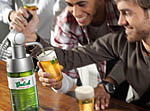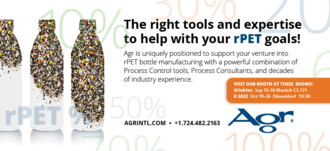Grolsch on tap – straight from your fridge
2-litre PET solution for draft beer – patented “Cheersch” system
|
|
When Grolsch approached Sidel in 2006 with a request to help design and produce draft beer packaging for home use, PET was not an obvious answer. PET-bottled beer had hitherto not been particularly successful in the Dutch market. Yet it proved to be the perfect material for a custom-made container tasked to cope with a tap-valve under high pressure while keeping beer fresh and fizzy. Using PET rather than other materials has many advantages. In contrast to glass, PET enables a custom-made bottle neck design which is necessary for a snug fit between bottle, valve, and tap unit. At the same time, PET can withstand the pressure necessary to allow drafting beer without electricity. The 2-liter bottle is lightweight and easy to handle.
The compact two-liter bottle is made from a special PET blend preform and produced on a Sidel blow moulding machine. The material and its custom-made seal mean a guaranteed shelf life of six months – exactly the same as with all other Grolsch containers (bottles and cans). The bottles are supplied with CO2 cartridges which enable the consumer to draft their Cheersch at the same pressure as the trade. The system uses a tap unit which only needs to be bought once and does not require electricity to work.
Sidel was chosen by Grolsch as the sole partner with responsibility for the whole line including sub-supplier Coster who produces the valve-inserter and closure unit. The Sidel line includes a Eurotronica FM-LT filler, a Rollquattro labeller, Robokombi palletizers and depalletizers, and conveyors. Close cooperation between Sidel and Grolsch enabled the product to come to market at an earlier date than originally planned, to allow for delivery in time for Father’s day and the European Championship in June 2008.
Beer packaging study challenges preconceptions
Environmental impact of cans, glass and PET bottles revealed
|
|
Using data from Belgian Martens Breweries, the study assesses the environmental impact of beer production and packaging, from ingredients hop to the package at its end of use. The so-called Life Cycle Assessment (LCA) looks at the impact of the production of 100 liters of beer in 0.5 l packages in terms of energy consumption, global warming, air acidification, eutrophication and water consumption.
“Environmental impact is an increasingly important factor when our customers decide which packaging to use for what product. Our packaging solutions must be backed by undisputable data,” says Luc Desoutter, Sustainability Officer at Sidel, describing the motivation for a “Life Cycle Assessment” the company commissioned on the different beer packaging options. Life Cycle Assess¬ment is a well-defined methodology, and ISO standards on LCA are available. Its goal is to compare the full range of environmental impact assignable to products and services in order to choose the least burdensome one.
The study compares the production of 100 litres of beer in four different types of packaging: PET bottles with Actis™ coating, glass long-neck bottles, aluminium cans and steel cans. It considers which option is least environmentally damaging in terms of resources and pollution over the full life cycle of beer. This includes the use of resources from the time grains are grown, harvested and used to make beer, to production of its primary packaging, delivery to supermarkets and customers, and finally to the package’s end of life, be it sent to the landfill, incineration or recycling plant. Data for the study came from Belgium (production and packaging) and the UK (distribution, consumption and disposal).
Primary packaging has the greatest environmental impact along with beer production
The results of the case study show steel cans and PET bottles contribute least to global warming and air acidification. The production of steel cans uses least primary energy and water, while glass is the highest consumer. The study draws several conclusions from these results. In terms of environ¬mental impact, primary packaging is the greatest along with beer production, while transport and secondary packaging are relatively small. Recycling rates are an important factor, especiallly for aluminum cans. Where aluminum can recycling rates are high, aluminium may be a good choice for packaging beer. The electric mix used for the production of packaging is an important parameter for the indicators “acidification”, “energy consumption” and “climate change”. The study also finds that if the weight of a 0.5l PET bottle can be at or below 20 grams, PET is the preferred overall choice in terms of climate change.
Key factors: recycling rates and packaging weight
Luc Desoutter: “The study identified the key factors which most influence environmental assessment. They were found to include recycling rates and the weight of the packaging. These insights enable us to determine which actions to implement to minimize the environmental impact of beer packaging. We can do this, for example, by improving recycling rates and by package lightweighting. The results of the study of course reflect the situation in the countries studied (Belgium for production, UK for consumption and end-of-life), at a given moment – recycling rates, transport distance and electricity mix vary across countries and over time.”
As a result of the study, a new “LCA User” tool has been developed to enable beer producers from everywhere in the world to make an informed decision regarding the most environment-friendly packaging solution for their products based on different scenarios.
The LCA assessment, which took its data from Martens Breweries industrial activities, was performed by RDC-Environment. Its conclusions and this press release were independently reviewed by Rene van Gijlswijk, an LCA expert from TNO in the Netherlands and Yvan Liziard, an LCA expert specializing in packaging. The LCA tool is available through Sidel. .
Beer in PET Bottles: The Sidel Combi, A World’s First
|
|
Sidel’s approach has always been to adapt its offer to specific market needs and to commit to localized solutions. In Eastern Europe, beer consumption is booming. PET packaging represents 9% of this market characterized by very specific needs: to package beer at the lowest possible cost, with high annual production volumes, in bottle formats up to 2.5 liters, and for a shelf life of less than two weeks on average. For this type of packaging, neither glass nor plastic with barrier coating is necessary. A simple PET bottle is sufficient. The Combi for beer is fully suited to these production requirements.
Initially designed in 1997 to package still water, the Combi family was later expanded to produce carbonated drinks and sensitive products. The Combi solution incorporates all major steps in a single system – blow molding, filling and capping – for packaging beverages and other liquid products in PET bottles. The Combi guarantees final product quality, while ensuring unrivaled productivity and efficiency at all output rates. Production speeds can reach 61,000 bottles per hour for 0.6-liter bottles, and 24,000 bottles per hour for 2-liter sizes.
Sensitive Product
A major requirement for brewers is not to alter the quality of this highly sensitive product. This requires advanced technology for hygiene. The Combi’s hermetically sealed enclosure contributes to package hygiene and preserves the beer’s flavor and aroma during flash pasteurization. The Combi takes all parameters into account in order to control the production environment and to reduce the risk of bottle contamination: preform and cap treatment, functional proximity between blow molding and filling, elimination of intermediate conveyors, continuous positive transfer by star wheel, and a clean environment in the transfer zone.
Precision Filling
The Combi’s filling section includes technology that has been specially designed for packaging beer in PET: Sidel’s Eurotronica FM-LT filler which ensures precision filling and a minimal presence of oxygen. Volumetric filling uses magnetic flow meters to ensure filling accuracy. Beer is filled through a long tube that reaches almost to the base of the bottle. Once the tube’s end is submerged in the beer, filling is turbulence-free, which reduces oxygen absorption. This is followed by CO2 flushing which reduces the amount of air in the bottle. Finally, prior to capping, a high-pressure “jetting” system creates very dense foam that replaces the air in the headspace up to the top of the bottle rim.
Compact and Simple
Another important feature for brewers is the Combi’s small footprint and its ease of integration. The Combi eliminates hundreds of meters of conveyors and results in a far smaller footprint. Operating costs are lower than with traditional lines, water and power consumption is decreased and, as a result, packaging costs and environmental impact are also reduced. Finally, because bottles are transferred by the neck, the Combi enables use of lightweight bottles and offers a wider range of possible shapes. This opens up innovative bottle design possibilities for brewers, giving them a distinct marketing edge in the traditional beer market.
Since the summer of 2008, the first two Sidel Combis for beer have been in production at two SABMiller Group breweries in Hungary and Romania, and a third is now in operation at a URBB Group brewery in Romania.
Sidel Supplies Four Complete Lines to Modelo for the Record-Setting Piedras Negras Brewery
|
|
One of the world’s largest beer makers, the Modelo Group is building a new brewery in Piedras Negras, Mexico near the U.S. border. The Group will produce 10 million hectoliters of beer annually at the new plant for export to the United States and Canada. Piedras Negras will supply almost all of the volume exported to North America, which represents Modelo’s second largest market after Mexico. Three brands will be produced at the new plant: Corona, Modelo Light and Modelo Especial.
When construction is complete in 2010, this fully automated plant will be one of the most modern in the world. Sidel is the sole source for the plant’s four packaging lines: one for cans and three for glass bottles.
The can line will run at a rate of 66,000 12 oz. (about 33 cl) containers per hour, while each of the three glass lines will bottle 12 oz. containers at a record-setting speed of 144,000 per hour. Each line will have two or three fillers and a pasteurizer. The end-of-line equipment – palletizers, depalletizers, craters and decraters – will all be supplied by Sidel.
The automation between the end-of-line and the warehouse is particularly modern, employing robots that can communicate with the laser-guided vehicles (LGVs) provided by Sidel affiliate Elettric80.
Pallets of empty bottles will be transported by LGV from the warehouse to the depalletizers, then the LGVs will return ull pallets from the palletizer to the warehouse. The LGVs can also be used to supply the lines with capsules, boxes and film.
The creation of wrapping islands served by Elettric80 forklifts enables the customer to greatly simplify site layout and work organization.
The warehouses supplied by Systems Logistics will be automated and connected to the glass plant warehouses via a tunnel.
The first line will be installed in the spring of 2009, and the first bottles will be produced and sold in 2010.
| Sylvie ORY Tel: +33 2 32 85 81 33 sylvie.ory@sidel.com |











